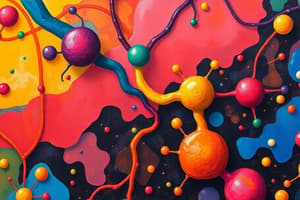Podcast
Questions and Answers
What is the primary catabolic pathway through which glucose and oxygen interact to produce carbon dioxide, water, and ATP in aerobic conditions?
What is the primary catabolic pathway through which glucose and oxygen interact to produce carbon dioxide, water, and ATP in aerobic conditions?
Cellular respiration
Which process do plants primarily use as their main anabolic pathway to create organic matter from simple inorganic substances?
Which process do plants primarily use as their main anabolic pathway to create organic matter from simple inorganic substances?
Photosynthesis
How do animals obtain glucose and other nutrients necessary for cellular respiration?
How do animals obtain glucose and other nutrients necessary for cellular respiration?
By consuming plant material
What are some regulatory factors that influence metabolism in living organisms?
What are some regulatory factors that influence metabolism in living organisms?
Why is understanding metabolism important in maintaining health and wellbeing?
Why is understanding metabolism important in maintaining health and wellbeing?
What is metabolism?
What is metabolism?
How do catabolism and anabolism differ?
How do catabolism and anabolism differ?
What is the role of catabolism in metabolism?
What is the role of catabolism in metabolism?
What is anabolism responsible for?
What is anabolism responsible for?
How does metabolism contribute to maintaining homeostasis?
How does metabolism contribute to maintaining homeostasis?
Flashcards are hidden until you start studying
Study Notes
Life Processes: Understanding Metabolism
Metabolism is one of the fundamental life processes that sustain living organisms. It's like a symphony of chemical reactions that allow us to grow, maintain our energy levels, and adapt to our environment. Let's delve into this vital process by examining its various aspects.
Overview
Metabolism encompasses all the biochemical reactions occurring within cells that convert nutrients from food into energy and essential cellular components needed for growth and repair. This intricate dance between catabolic and anabolic pathways allows us to break down complex molecules into their simpler forms while simultaneously constructing new compounds for survival and reproduction. Although we often associate metabolism with calorie burning and weight management, it plays a much more extensive role in maintaining homeostasis and keeping us alive.
Catabolism VS Anabolism
Catabolism refers to energy-releasing processes involved in breaking down larger molecules such as carbohydrates, lipids, proteins, and nucleic acids. These reactions yield smaller molecules that release stored chemically bound energy, which can later be used in numerous ways, including powering muscle contractions, synthesizing ATP (Adenosine Triphosphate), and maintaining body temperature. On the other hand, anabolism involves biosynthesis—the construction of large organic molecules from small precursors using energy derived from catabolism. Ultimately, these two opposing processes work together to support life functions.
Cellular Respiration and Photosynthesis
Cellular respiration is a primary catabolic pathway through which glucose and oxygen interact to produce carbon dioxide, water, and ATP in aerobic conditions. Ironically, plants use photosynthesis as their main anabolic process to create organic matter from simple inorganic substances, primarily sunlight, water, and carbon dioxide. In turn, animals consume plant material to obtain glucose and other nutrient sources necessary for cellular respiration.
Regulation of Metabolism
Living things have evolved sophisticated mechanisms to regulate metabolism according to environmental demands. For example, hormones like insulin and cortisol govern blood sugar levels, while thyroid hormones regulate basal metabolic rate—a measure of overall energy expenditure by the body. Similarly, circadian rhythms influence sleep patterns and feeding behavior, impacting diurnal versus nocturnal metabolic rates. Additionally, organisms respond to external cues such as temperature and light intensity to adjust their metabolic activity accordingly.
In summary, understanding metabolism sheds light on the dynamic interactions occurring within living systems to maintain health and wellbeing. By exploring the balance between catabolism and anabolism, investigating key processes like cellular respiration and photosynthesis, and recognizing regulatory factors, we learn how nature sustains itself and develop insights into improving human physiology and disease prevention strategies.
Studying That Suits You
Use AI to generate personalized quizzes and flashcards to suit your learning preferences.



